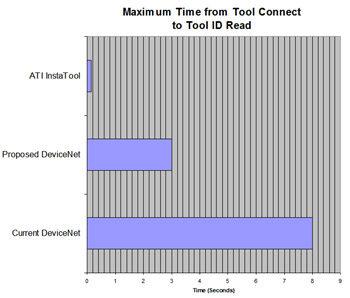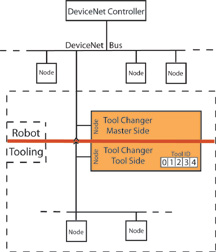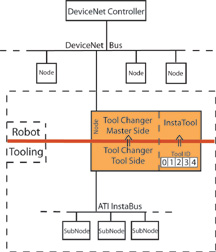|
InstaToolT
New
innovation greatly reduces time for tool changes in
DeviceNet environments.
 DeviceNetT
is a popular industrial communications bus used to connect
industrial devices and reduce or eliminate time-consuming discrete
wiring. DeviceNetT
is a popular industrial communications bus used to connect
industrial devices and reduce or eliminate time-consuming discrete
wiring.
The Problem
With the obvious benefits of DeviceNet technology comes the
inevitable delay that occurs during tool
identification - as long as 8 seconds at each tool change. The
cumulative effect of these delays is a loss of production time. This
compounded effect becomes a factor in reducing manufacturing
productivity.
In an effort to minimize this delay, a new DeviceNet standard is
being proposed which could potentially reduce this delay to 2 to 3
seconds. This is still a noticeable delay during an application
process.
ATI InstaToolT solves the problem.
 The
Solution: ATI InstaToolTM Technology The
Solution: ATI InstaToolTM Technology
With ATI InstaToolT, long delays for tool identification and tooling
I/O are a thing of the past.
By using ATI InstaToolT technology, the new tool-side module
communicates tool ID and tooling I/O to the master/robot module in
just tenths of a second after tool changer coupling. There is no
longer a need to establish a DeviceNet node on the tool side, which
in turn prevents power-ups from negotiating lengthy DeviceNet
protocol sequences. Tooling is available on the network in under a
second.
Best of all, there are no costly upgrades of DeviceNet scanner and
master controller equipment required to enjoy the substantial
benefits of ATI InstaToolT.
Product Advantages
-
Near-Instant
Connection and Tool Identification: With InstaTool, tool ID
occurs within 150 milliseconds, as compared to up to 8 seconds
using current technology. Tool I/O is available within 700
milliseconds.
-
Reduction in Time:
No delay means overall cycle time is reduced and production is
increased. This advantage is heightened in applications with
multiple tool changes.
Reduced DeviceNet Node Management: With ATI InstaToolT and
InstaBusT technology, the tool changer master node handles 160 I/O
communications downstream, resulting in fewer DeviceNet nodes to
manage.
-
Tool ID Passes
Through Master: Systems with multiple masters and tools can
positively identify which tools are connected to each master.
-
Tool Stand
Interlock (TSI): A tool stand interlock feature is provided on
the tool/slave side for safer tool changer operation. The TSI
allows uncoupling only when the tool changer is in the tool stand.
Customers have the option to choose mechanical or proximity sensor
switches to close the TSI circuitry.
-
Additional Safety
Features: Additional DeviceNet inputs are provided to identify
unsafe operating conditions. Customer operating software can be
programmed to halt tool changer operation when unsafe conditions
exist.
DeviceNet - with and without ATI InstaToolTM
The illustrations below indicate the fundamental differences between
standard DeviceNet connectivity and the new ATI InstaToolT
technology.
| Current Network
Before ATI InstaToolT, the
DeviceNet signal passed from the DeviceNet controller, through
the master side to the tool side of the tool changer, then on
to the nodes. With this method, each time a new tool side
connection is made, up to an 8 second start-up delay occurs
before tool identification is made and the application can
continue. |
 |
| |
|
ATI Solution
With InstaToolT, the DeviceNet signal effectively stops at the
tool changer master, creating an always-on connection to that
master node. Using patent-pending high-speed technology, the
master node handles all I/O communication downstream from the
master. The result is a connect time of less than 150
milliseconds for tool ID and under 700 milliseconds for tool
I/O. Tool I/O appears at the master node. |
 |
Top |